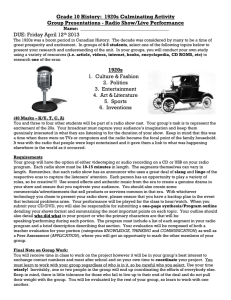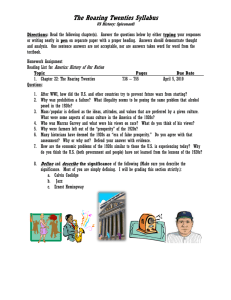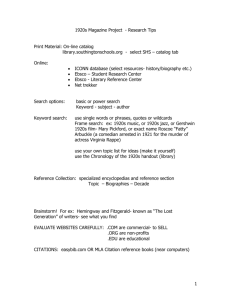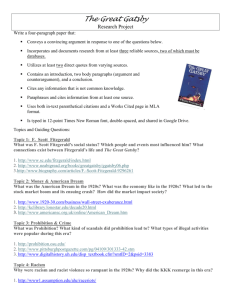The 1920s - Cloudfront.net
advertisement
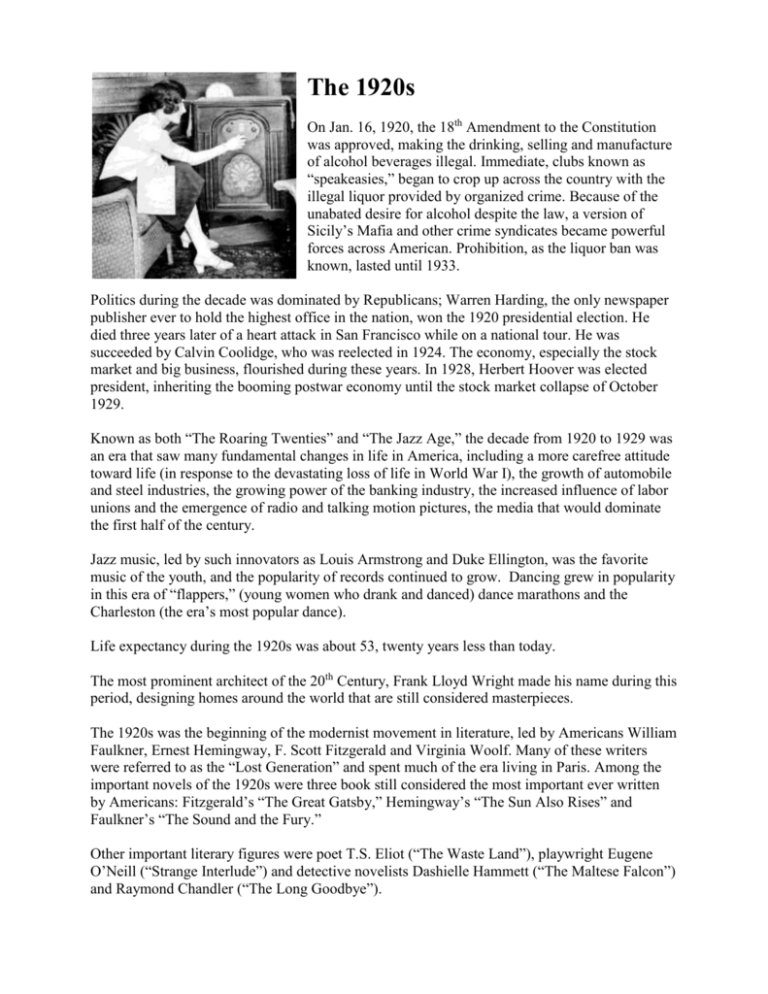
The 1920s On Jan. 16, 1920, the 18th Amendment to the Constitution was approved, making the drinking, selling and manufacture of alcohol beverages illegal. Immediate, clubs known as “speakeasies,” began to crop up across the country with the illegal liquor provided by organized crime. Because of the unabated desire for alcohol despite the law, a version of Sicily’s Mafia and other crime syndicates became powerful forces across American. Prohibition, as the liquor ban was known, lasted until 1933. Politics during the decade was dominated by Republicans; Warren Harding, the only newspaper publisher ever to hold the highest office in the nation, won the 1920 presidential election. He died three years later of a heart attack in San Francisco while on a national tour. He was succeeded by Calvin Coolidge, who was reelected in 1924. The economy, especially the stock market and big business, flourished during these years. In 1928, Herbert Hoover was elected president, inheriting the booming postwar economy until the stock market collapse of October 1929. Known as both “The Roaring Twenties” and “The Jazz Age,” the decade from 1920 to 1929 was an era that saw many fundamental changes in life in America, including a more carefree attitude toward life (in response to the devastating loss of life in World War I), the growth of automobile and steel industries, the growing power of the banking industry, the increased influence of labor unions and the emergence of radio and talking motion pictures, the media that would dominate the first half of the century. Jazz music, led by such innovators as Louis Armstrong and Duke Ellington, was the favorite music of the youth, and the popularity of records continued to grow. Dancing grew in popularity in this era of “flappers,” (young women who drank and danced) dance marathons and the Charleston (the era’s most popular dance). Life expectancy during the 1920s was about 53, twenty years less than today. The most prominent architect of the 20th Century, Frank Lloyd Wright made his name during this period, designing homes around the world that are still considered masterpieces. The 1920s was the beginning of the modernist movement in literature, led by Americans William Faulkner, Ernest Hemingway, F. Scott Fitzgerald and Virginia Woolf. Many of these writers were referred to as the “Lost Generation” and spent much of the era living in Paris. Among the important novels of the 1920s were three book still considered the most important ever written by Americans: Fitzgerald’s “The Great Gatsby,” Hemingway’s “The Sun Also Rises” and Faulkner’s “The Sound and the Fury.” Other important literary figures were poet T.S. Eliot (“The Waste Land”), playwright Eugene O’Neill (“Strange Interlude”) and detective novelists Dashielle Hammett (“The Maltese Falcon”) and Raymond Chandler (“The Long Goodbye”). The 1920s also saw the emergence of African-American artists and activists writing and express about the struggles of black Americans. Among the important black writers central to the movement that was known as the “Harlem Renaissance” were poet Langston Hughes, novelist Zora Neale Hurston and political activists W.E.B. Du Bois, Marcus Garvey and Alain Locke. In 1929, the first Academy Award ceremony was held at the Roosevelt Hotel in Hollywood, where they awarded “Wings,” a silent film about World War I, the best picture Oscar for 192728. Silent actors Rudolph Valentino, Douglas Fairbanks, John Barrymore, Lillian Gish and Mary Pickford were among the first popular celebrities of America. But the biggest star in Hollywood during the 1920s was a British comedian named Charlie Chaplin, who turned his character, “the Little Tramp” into the most famous image in the world. His films during the 1920s included “City Lights” and “The Gold Rush.” In 1927, Warner Bros. released the first movie with sound (but not much), “The Jazz Singer.” Overnight, the movie industry changed, ending many performer’s careers—especially those who weren’t born in the U.S. and spoke with accents—and within a year nearly every American film was made with sound. After losing the rights to his first successful cartoon character, “Oswald the Lucky Rabbit,” animator Walt Disney creates Mickey Mouse and, in 1928, releases the first sound short featuring the happy-go-lucky mouse called “Steamboat Willie.” The Broadway musical became an American institution during the 1920s, beginning with Oscar Hammerstein and Jerome Kern’s “Showboat” in 1927, one of the first shows to incorporate a dramatic story with music. Also important composers of the time were Irving Berlin (“White Christmas”) and George Gershwin (“An American in Paris”). Some of the greatest legends in American sports were at the peak of their careers during the 1920s, and it is often referred to as the “the Golden Age of Sports.” Among the stars of the era were Babe Ruth, the baseball pitcher turned home run hitter who is still considered the greatest player in the sport’s history; Red Grange, the first star of the newly formed National Football League; Jack Dempsey, one of the most successful boxers; Bill Tilden, among the first superstars of tennis; and Bobby Jones and Walter Hagen, the first great American golfers. In 1927, Charles Lindbergh flew his plane, “The Spirit of St. Louis,” across the Atlantic, landing in Paris to become the first to accomplish the feat. He immediately became one of the most famous men in the world. The party ended in October of 1929, when the stock market, predicting the Great Depression that would dominate life in American for the next 15 years, lost about $30 billion in value in a two day span.



